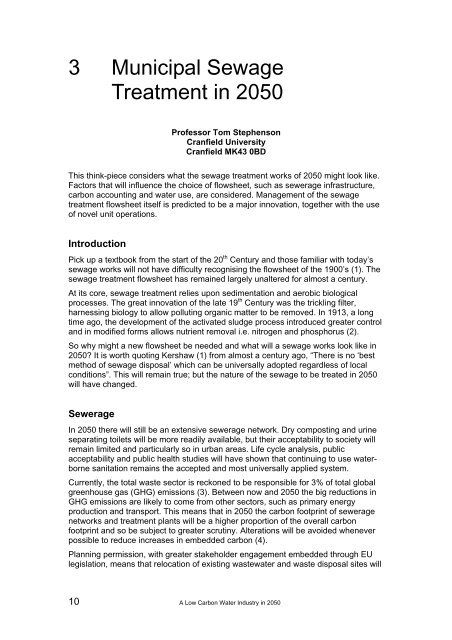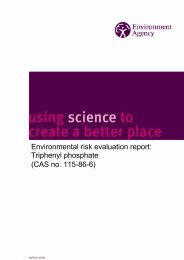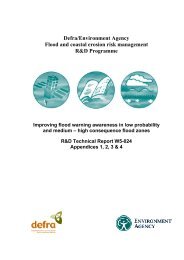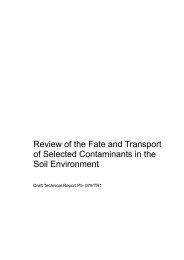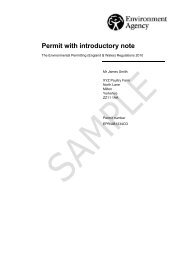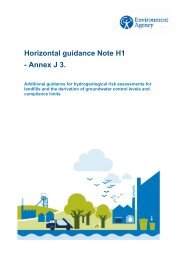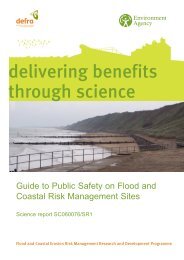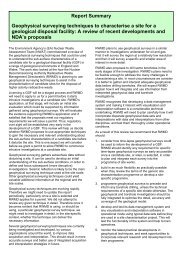A Low Carbon Water Industry in 2050 - Environment Agency
A Low Carbon Water Industry in 2050 - Environment Agency
A Low Carbon Water Industry in 2050 - Environment Agency
Create successful ePaper yourself
Turn your PDF publications into a flip-book with our unique Google optimized e-Paper software.
3 Municipal Sewage<br />
Treatment <strong>in</strong> <strong>2050</strong><br />
Professor Tom Stephenson<br />
Cranfield University<br />
Cranfield MK43 0BD<br />
This th<strong>in</strong>k-piece considers what the sewage treatment works of <strong>2050</strong> might look like.<br />
Factors that will <strong>in</strong>fluence the choice of flowsheet, such as sewerage <strong>in</strong>frastructure,<br />
carbon account<strong>in</strong>g and water use, are considered. Management of the sewage<br />
treatment flowsheet itself is predicted to be a major <strong>in</strong>novation, together with the use<br />
of novel unit operations.<br />
Introduction<br />
Pick up a textbook from the start of the 20 th Century and those familiar with today’s<br />
sewage works will not have difficulty recognis<strong>in</strong>g the flowsheet of the 1900’s (1). The<br />
sewage treatment flowsheet has rema<strong>in</strong>ed largely unaltered for almost a century.<br />
At its core, sewage treatment relies upon sedimentation and aerobic biological<br />
processes. The great <strong>in</strong>novation of the late 19 th Century was the trickl<strong>in</strong>g filter,<br />
harness<strong>in</strong>g biology to allow pollut<strong>in</strong>g organic matter to be removed. In 1913, a long<br />
time ago, the development of the activated sludge process <strong>in</strong>troduced greater control<br />
and <strong>in</strong> modified forms allows nutrient removal i.e. nitrogen and phosphorus (2).<br />
So why might a new flowsheet be needed and what will a sewage works look like <strong>in</strong><br />
<strong>2050</strong> It is worth quot<strong>in</strong>g Kershaw (1) from almost a century ago, “There is no ‘best<br />
method of sewage disposal’ which can be universally adopted regardless of local<br />
conditions”. This will rema<strong>in</strong> true; but the nature of the sewage to be treated <strong>in</strong> <strong>2050</strong><br />
will have changed.<br />
Sewerage<br />
In <strong>2050</strong> there will still be an extensive sewerage network. Dry compost<strong>in</strong>g and ur<strong>in</strong>e<br />
separat<strong>in</strong>g toilets will be more readily available, but their acceptability to society will<br />
rema<strong>in</strong> limited and particularly so <strong>in</strong> urban areas. Life cycle analysis, public<br />
acceptability and public health studies will have shown that cont<strong>in</strong>u<strong>in</strong>g to use waterborne<br />
sanitation rema<strong>in</strong>s the accepted and most universally applied system.<br />
Currently, the total waste sector is reckoned to be responsible for 3% of total global<br />
greenhouse gas (GHG) emissions (3). Between now and <strong>2050</strong> the big reductions <strong>in</strong><br />
GHG emissions are likely to come from other sectors, such as primary energy<br />
production and transport. This means that <strong>in</strong> <strong>2050</strong> the carbon footpr<strong>in</strong>t of sewerage<br />
networks and treatment plants will be a higher proportion of the overall carbon<br />
footpr<strong>in</strong>t and so be subject to greater scrut<strong>in</strong>y. Alterations will be avoided whenever<br />
possible to reduce <strong>in</strong>creases <strong>in</strong> embedded carbon (4).<br />
Plann<strong>in</strong>g permission, with greater stakeholder engagement embedded through EU<br />
legislation, means that relocation of exist<strong>in</strong>g wastewater and waste disposal sites will<br />
10 A <strong>Low</strong> <strong>Carbon</strong> <strong>Water</strong> <strong>Industry</strong> <strong>in</strong> <strong>2050</strong>


